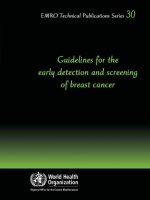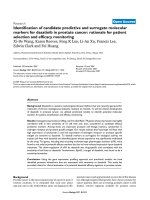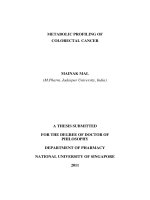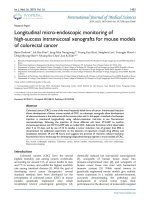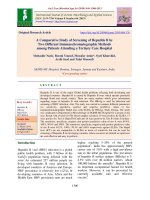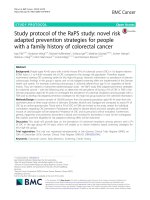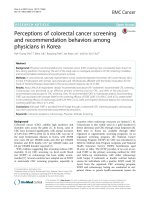High-throughput screening of salivary polyamine markers for discrimination of colorectal cancer by multisegment injection capillary electrophoresis tandem mass spectrometry
Bạn đang xem bản rút gọn của tài liệu. Xem và tải ngay bản đầy đủ của tài liệu tại đây (2.79 MB, 9 trang )
Journal of Chromatography A 1652 (2021) 462355
Contents lists available at ScienceDirect
Journal of Chromatography A
journal homepage: www.elsevier.com/locate/chroma
High-throughput screening of salivary polyamine markers for
discrimination of colorectal cancer by multisegment injection capillary
electrophoresis tandem mass spectrometry
Kaori Igarashi a, Sana Ota a, Miku Kaneko a, Akiyoshi Hirayama a, Masanobu Enomoto b,
Kenji Katumata b, Masahiro Sugimoto a,c, Tomoyoshi Soga a,d,∗
a
Institute for Advanced Biosciences, Keio University, 246-2 Mizukami, Kakuganji, Tsuruoka 997-0052, Japan
Department of Gastrointestinal and Pediatric Surgery, Tokyo Medical University, 6-7-1, Nishijinjuku, Shinjuku, Tokyo 160-0023, Japan
c
Research and Development Center for Minimally Invasive Therapies, Medical Research Institute, Tokyo Medical University, 6-1-1, Sinjuku, Tokyo 160-0022,
Japan
d
Faculty of Environmental Information Studies, Keio University, 5322 Endo, Fujisawa 252-0882, Japan
b
a r t i c l e
i n f o
Article history:
Received 13 April 2021
Revised 3 June 2021
Accepted 15 June 2021
Available online 20 June 2021
Keywords:
Multisegment injection
capillary electrophoresis
Mass spectrometry
Saliva
Polyamine
Biomarker
Colorectal cancer
a b s t r a c t
Polyamine metabolites provide pathophysiological information on disease or therapeutic efficacy, yet
rapid screening methods for these biomarkers are lacking. Here, we developed high-throughput
polyamine metabolite profiling based on multisegment injection capillary electrophoresis triple
quadrupole tandem mass spectrometry (MSI-CE-MS/MS), which allows sequential 40-sample injection
followed by electrophoretic separation and specific mass detection. To achieve consecutive analysis of
polyamine samples, 1 M formic acid was used as the background electrolyte (BGE). The BGE spacer volume had an apparent effect on peak resolution among samples, and 20 nL was selected as the optimal
volume. The use of polyamine isotopomers as the internal standard enabled the correction of matrix
effects in MS detection. This method is sensitive, selective and quantitative, and its utility was demonstrated by screening polyamines in 359 salivary samples within 360 min, resulting in discrimination of
colorectal cancer patients from noncancer controls.
© 2021 The Authors. Published by Elsevier B.V.
This is an open access article under the CC BY license ( />
1. Introduction
Recent analysis of the entire set of low-molecular-weight biological compounds (metabolome) has revealed new biomarkers
that correlate with disease severity and that respond to therapeutic efficacy or toxicity [1–4]. However, few metabolite biomarkers
have been implemented in clinical practice because unlike proteins
and peptides, it is difficult to produce monoclonal or polyclonal
antibodies for low-molecular-weight molecules [5]; therefore, developing rapid screening methods such as the enzyme-linked immunosorbent assay (ELISA) commonly used in clinical laboratories
is challenging.
∗
Corresponding author at: Institute for Advanced Biosciences, Keio University,
246-2 Mizukami, Kakuganji, Tsuruoka, Yamagata 997-0052 Japan.
E-mail addresses: (K. Igarashi),
(S. Ota), (M. Kaneko), (A. Hirayama), (M. Enomoto), (K. Katumata), (M. Sugimoto), (T. Soga).
GC/MS and LC-MS are commonly used for the analysis of lowmolecular-weight compounds. However, these approaches require
more than 10 min per sample due to the low sample throughput
associated with solute elution and column preconditioning; thus,
the costs associated with these techniques preclude their clinical
application.
Capillary electrophoresis mass spectrometry (CE-MS) is a powerful tool for the comprehensive analysis of charged metabolites
[6,7]. In this marriage of techniques, CE confers rapid analysis and
efficient resolution, and MS provides high selectivity and sensitivity [6]; thus, CE-MS metabolomics has been widely applied in a
variety of fields [4,8–10]. Recently, Britz-McKibbin et al. [11–16] reported the multisegment injection (MSI)-CE-MS method, which allows sequential multisample injection in series within a capillary
tube using the sample stacking technique and enables many sample measurements within a single run.
Polyamines such as spermine, spermidine and their Nacetylated forms are low-molecular-weight cations. Because of
their positive charges, polyamines bind to DNA and RNA and are
involved in a variety of biological processes, including gene expres-
/>0021-9673/© 2021 The Authors. Published by Elsevier B.V. This is an open access article under the CC BY license ( />
K. Igarashi, S. Ota, M. Kaneko et al.
Journal of Chromatography A 1652 (2021) 462355
sion and translation, cell proliferation, membrane stabilization, and
organ development [17–19]. In cancer, polyamine metabolism is
frequently dysregulated, indicating that elevated polyamine levels
are necessary for transformation and tumor progression [20]. Recently, polyamines have attracted much attention not only as targets for anticancer strategies but also as diagnostic tools [19,21,22].
Thus, a high-throughput screening method for these biomarkers is
urgently needed.
Here, we developed a high-throughput MSI-CE-tandem mass
spectrometry (MS/MS) method that allowed 40 consecutive analyses of salivary polyamines within 40 min, resulting in the discrimination of colorectal cancer (CRC) patients from noncancer controls.
2.5. Instrumentation
All CE-MS experiments were performed using an Agilent G1600
CE system, an Agilent 6410 triple-quadrupole MS/MS system, an
Agilent 6210 time-of-flight mass spectrometry (TOFMS) system, an
Agilent 1100 series isocratic HPLC pump, a G1603A Agilent CE-MS
adapter kit and a G1607A Agilent CE-ESI-MS sprayer kit (all Agilent
Technologies, Santa Clara, CA). The CE-MS adapter kit included a
capillary cassette that facilitates thermostating of the capillary, and
the CE-ESI-MS sprayer kit, which simplifies coupling the CE system with MS systems, was equipped with an electrospray source.
LC-MS/MS was performed using an Agilent 1290 Infinity LC system comprised a HiP autosampler, quaternary pump and column
compartment, and an Agilent 6460 triple-quadrupole MS/MS system. Electrical conductivities were measured by a Yokogawa 73,301
Digital Multi Meter.
2. Materials and methods
2.1. Chemicals
N1-Acetylspermidine (N1-Ac-Spd), N8-acetylspermidine (N8-AcSpd)-d3 and spermine-d20 were purchased from Toronto Research Chemicals (Toronto, Canada); N1-Ac-Spd-d6, N1,N8-diacetylspermidine (N1,N8-DiAc-Spd)-d6, N1-acetylspermine (N1-Ac-Spm)d3 and N1,N12-diacetylspermine (N1,N12-DiAc-Spm)-d6 were purchased from Santa Cruz Biotechnology (Dallas, TX); creatinined3 was purchased from Taiyo Nippon Sanso (Tokyo, Japan); and
spermidine-d3 was purchased from IsoSciences (Ambler, PA). All
other reagents were obtained from Sigma-Aldrich (St. Louis, MO)
or Wako (Osaka, Japan). Water was purified with a Milli-Q purification system (Millipore, Bedford, MA).
2.6. MSI-CE-MS/MS conditions for polyamine analysis
Fused-silica capillaries with 50 μm i.d. x 110 cm total length
were used as the separation capillary. The background electrolyte
(BGE) for MSI-CE separation was a 1 M formic acid solution. Prior
to first use, a new capillary was pretreated with BGE for 20 min.
Before MSI injection, the capillary was preconditioned for 4 min
by flushing with BGE. Samples were injected with a pressure injection of 50 mbar, alternating between 1 s (~1 nL) for each sample
plug and 20 s (~20 nL) for the BGE spacer plug for a total of 40
discrete samples analyzed within a single run. The applied voltage
was set at 30 kV, the capillary temperature was thermostated to
20°C, and the sample tray was cooled below 5°C. An Agilent 1100
series pump equipped with a 1:100 splitter was used to deliver
10 μL/min of 5 mM ammonium acetate in 50% (v/v) methanolwater to the CE interface, where it was used as a sheath liquid
around the outside of the CE capillary to provide a stable electrical connection between the tip of the capillary and the grounded
electrospray needle. The mass spectrometer was operated in multireaction monitoring (MRM) mode using positive ionization, and a
40 0 0 V ion spray voltage was applied. The flow rate of nebulizer
nitrogen gas and drying nitrogen gas (heater temperature 300°C)
was maintained at 10 psig and 10 L/min, respectively. The Q1 (protonated precursor ion), Q3 (production), fragmentor and collision
energy for each polyamine and creatinine are listed in Table 1.
2.2. Clinical samples
This study was conducted according to the Declaration of
Helsinki principles. The study protocol was approved by the Ethics
Committee of Tokyo Medical University (No. 2346). Written informed consent was obtained from each subject before participating in the study. The 359 collected saliva samples, including 57
healthy controls (HCs), 26 patients with benign colorectal tumors
(BCTs) and 276 patients with CRC (Table S1), were divided into
nine batches, and each batch comprising 39 or 40 saliva filtrates
was applied to the MSI-CE-MS/MS system.
2.3. Saliva collection
Saliva providers were not allowed to take any food except water intake after 9:00 p.m. on the previous day. They were required
to brush their teeth without toothpaste on the day of saliva collection and had to refrain from drinking water, smoking, toothbrushing, and intense exercise 1h before saliva collection. Before
saliva collection, they were required to gargle with water and then
all saliva samples were collected from 8:00 to 11:00 a.m. Approximately 400 μL of unstimulated saliva was collected in a 50 mL
polypropylene tube using a polypropylene straw 1.1 cm in diameter
to assist the saliva collection. After collection, saliva samples were
immediately stored at -80°C. Creatinine normalization was used to
correct for differences in salivary rate/hydration status that contributes to greater biological variability.
2.7. CE-TOFMS and CE-MS/MS conditions for single-sample analysis
Fused-silica capillaries with 50 μm i.d. x110 cm total length
were used as the separation capillary. Samples were injected at
50 mbar for 5 s (~5 nL). For CE-TOFMS, the fragmentor, skimmer,
and Oct RFV voltages were set at 75 V, 50 V, and 125 V, respectively. A flow rate of drying nitrogen gas was maintained at 7
L/min. Methanol-water (50% v/v) containing 0.1 μM hexakis(2,2difluoroethoxy)pho-sphazene was delivered as the sheath liquid
at 10 μL/min. Automatic recalibration of each acquired spectrum
was performed using reference masses of reference standards ([13C
isotopic ion of protonated methanol dimer (2CH3OH+H)]+, m/z
66.06306) and protonated hexakis+, m/z 622.02896). Exact mass
data were acquired at a rate of 1.5 spectra/s over a 50–10 0 0 m/z
range. For CE-MS/MS, methanol-water (50% v/v) was delivered as
the sheath liquid at 10 μL/min. Others were identical to those used
in MSI-CE-MS/MS conditions.
2.4. Sample preparation
Saliva (90 μL) samples were transferred to 1.5 mL polypropylene
reaction tubes (Greiner Bio-One International, Tokyo, Japan), and
10 μL Milli-Q water containing 100 μM creatinine-d3 and 10 μM
each polyamine isotopomer was added to the tube. The solution
was vortexed for 10 s and then centrifugally filtered through a PallNanosep-3-kDa Omega cutoff filter (Pall Corporation, Japan) to remove proteins and other macromolecules at 9100 × g for 3 h at
4°C. Then, the filtrate was injected into CE-MS/MS system.
2.8. LC-MS/MS conditions for single-sample analysis
The analytical conditions were identical to those of LC-triple
quadrupole MS described by Tomita et al. [22].
2
K. Igarashi, S. Ota, M. Kaneko et al.
Journal of Chromatography A 1652 (2021) 462355
Table 1
Optimized MRM parameters for each polyamine and its isotopomer.
Compound
Q1(m/z)
Q3(m/z)
Fragmentor (V)
Collision Energy (V)
Creatinine
Creatinine-d3
Spermidine
Spermidine-d8
N1-Ac-Spd
N1-Ac-Spd-d6
N8-Ac-Spd
N8-Ac-Spd-d3
Spermine
Spermine-d20
N1,N8-DiAc-Spd
N1,N8-DiAc-Spd-d6
N1-Ac-Spm
N1-Ac-Spm-d3
N1,N12-DiAc-Spm
N1,N12-DiAc-Spm-d6
114
117
146
154
188
194
188
191
203
223
230
236
245
248
287
293
86
89
72
80
100
106
114
117
112
126
100
103
100
103
100
103
100
100
90
90
105
105
110
110
90
90
125
125
120
120
125
125
8
8
17
17
12
12
16
16
17
17
16
16
20
20
24
24
2.9. Data analysis
and electrophoresis occurs (Fig. 1c). This phenomenon allows sequential multiple sample injection in series within a capillary, followed by electrophoretic separation and mass detection (Fig. 1d).
As we reported previously, formic acid showed excellent resolution
capability for various cationic species [6,7,23] and was selected as
the BGE. The effect of its concentration on spermidine resolution
among samples was examined, and the highest formic acid concentration (1 M) provided better resolution in 40 consecutive spermidine standard analyses (Fig. 2S).
Another key was the BGE spacer volume, which significantly affected spermidine resolution among the samples. When the BGE
spacer volume was less than 10 nL, poor resolution occurred
(Fig. 2). On the other hand, although better resolution was obtained, spermidine peaks from the 1st to 8th samples in the
electrophero-gram were eluted from the separation capillary at
40 nL. The use of 20 nL provided good resolution for spermidine
peaks in all 40 samples (Fig. 2); thus, we selected 20 nL as the
BGE spacer volume.
Using the MSI-CE-MS/MS method, we demonstrated 40 consecutive analyses of a polyamine standard mixture containing spermiddine, N1-Acetylspermidine (N1-Ac-Spd), N8-Acetylspermidine
(N8-Ac-Spd),
spermine,
N1,N8-diacetylspermidine
(N1,N8DiAc-Spd),
N1-acetylspermine
(N1-Ac-Spm)
and
N1,N12diacetylspermine (N1,N12-DiAc-Spm). Unexpectedly, although
their concentrations were identical, the peak area and height of
each polyamine fluctuated (Fig. 3 in purple). We presumed that
this phenomenon might be due to matrix effects, which are caused
by the alteration of ionization efficiency of target analytes in the
presence of coeluting compounds in MS.
To confirm this, we analyzed the standard mixture spiked with
their isotope-labeled standards and found that the fluctuation patterns between each polyamine and its isotope-labeled standard
were closely matched (Fig. 3 in grey), which suggested that matrix
effects could be normalized by isotope-labeled standards. Furthermore, the use of polyamine isotopomers as the internal standard
solved another important peak identification problem in CE-MS
data where migration time variations between samples are significant [7]. In the MSI-CE-MS/MS method, polyamine identification
was performed based on its accurate mass (m/z) and comigration
with a matching isotope-labeled standard as reported [16].
Validation of this MSI-CE-MS/MS method was performed, and
the results are listed in Table 2. Reproducibility corrected by
isotope-labeled internal standards was practical; the relative peak
areas for all polyamines with relative standard deviation (RSD)
values (n = 40) were between 3.1 and 9.1%. The calibration
curves for all polyamines were linear in the range between 0.1
We developed a data analysis tool called MSI-MasterHands that
can enable peak detection and integration of MSI-CE-MS/MS data.
The tool detected the peak top of each peak through the use of
Python’s PeakUtils library, and determined the peak boundary by
the minimum intensity between each peak top. Then the peak area
of every peak was calculated by integrating the intensity between
the two boundaries. Subsequently, the concentration in each sample was calculated by comparison of peak area of analyte with that
of its corresponding isotope-labeled polyamine standard. To evaluate the difference of the metabolite concentrations among three
gropus, Kruskal-Wallis and Dunn’s test was used. To evaluate the
consistency among the three analytical methods, simple linear regressions were conducted. These analyses were conducted using
GraphPad (v8.4.3, GraphPad Software, San Diego, CA, USA). The receiver operating characteristic (ROC) curve analysis was conducted
using MetaboAnalyst (ver 5.0, />3. Results and discussion
3.1. Development of a high-throughput MSI-CE-MS/MS method for
polyamine analysis
Biological samples contain many isomers that are detected at
the same m/z value; thus, in the case of the MSI-CE-MS system, these isomers are expected to overlap with others from different samples. To confirm the presence of isomers, we analyzed
polyamines in a saliva sample with normal single injection CETOFMS and CE-MS/MS (Fig. 1S). As expected, several isomers, including N1- and N8-acetylspermidine, were detected at the same
m/z value by CE-TOFMS. However, CE-MS/MS with multireaction
monitoring (MRM) provided sufficient selectivity, resulting in the
detection of every polyamine at different m/z values. Therefore, we
selected CE-MS/MS for further experiments.
Then, we developed an MSI-CE-MS/MS method to achieve highthroughput screening of polyamine biomarkers. One of the keys to
success in expanding MSI to large-scale consecutive sample analysis was to amplify the sample stacking effect. Theoretically, sample
stacking effectively occurs when the sample plug exhibits lower
electrical conductivity than the BGE spacer because this condition exhibits greater voltage in the sample zone (Fig. 1a,b). Thus,
polyamines migrate fast in the sample zone but slowly in the BGE
spacer, which results in the concentration of polyamines at the
sample and BGE boundary (Fig. 1b). Afterwards, when the sample zone and the BGE are mixed, the voltage becomes constant,
3
K. Igarashi, S. Ota, M. Kaneko et al.
Journal of Chromatography A 1652 (2021) 462355
Fig. 1. Explanatory diagram of the MSI-CE-MS/MS method for polyamine analysis. (a) The samples and BGE are alternately injected into a single capillary. (b) Sample stacking
of polyamines occurs when the sample plug exhibits lower electrical conductivity than the BGE. (c) Electrophoresis starts when the voltage becomes constant by mixing the
sample and BGE solutions. (d) Polyamines in each sample are consecutively detected by tandem mass spectrometry at their specific m/z values. E and the red line indicate
the electromotive force and the voltage applied, respectively (For interpretation of the references to color in this figure legend, the reader is referred to the web version of
this article.).
Fig. 2. Effect of BGE spacer volume on spermidine resolution among samples. The spermidine standard (20 μM each) was injected 40 times consecutively and simultaneously
analyzed by MSI-CE-MS/MS.
and 10 0 0 μmol/L with correlation coefficients above 0.9898. This
method was considerably sensitive, and the concentration detection limits for the polyamines were between 2.9 and 21 nmol/L
with a pressure injection of 50 mbar for 1 s (1 nL); i.e., mass detection limits ranged from 2.9 to 21 amol at a signal-to-noise ratio
of 3.
3.2. High-throughput analysis of salivary polyamines from colorectal
cancer patients
Recently, salivary and urinary polyamines have been reported as
promising biomarkers in various cancers, such as oral, breast, colorectal and pancreatic cancers [19,24–26]. In many types of can4
K. Igarashi, S. Ota, M. Kaneko et al.
Journal of Chromatography A 1652 (2021) 462355
Fig. 3. Fluctuation of peak heights and areas in 40 consecutive analyses of polyamine standards (1 μM each, purple) and their deuterium-labeled isotopomers (1 μM each,
grey) with MSI-CE-MS/MS. Abbreviations: DiAc, diacetyl; Spm, spermine; Ac, acetyl; and Spd, spermidine (For interpretation of the references to color in this figure legend,
the reader is referred to the web version of this article.).
Table 2
Reproducibility, linearity, and sensitivity for polyamine standard analysis.
Compound
RSDa (n = 40) (%)
Linearityb Correlation
Detection Limit (nmol/L)
Spermidine
N8-Ac-Spd
N1-Ac-Spd
Spermine
N1,N8-DiAc-Spd
N1-Ac-Spm
N1,N12-DiAc-Spm
5.0
9.1
6.4
8.4
3.1
7.6
4.5
0.9898
0.9946
0.9912
0.9926
0.9913
0.9971
0.9913
18
21
14
4.8
2.9
4.5
4.6
a
RSD was calculated by the relative peak area, in which the peak area was divided by the peak
area of its isotopomer.
b
Calibration curves for all compounds were plotted at 0.1, 0.2, 0.5, 1, 2, 5, 10, 20, 50, 100, 200,
500 and 1000 μmol/L.
cer, the MYC oncogene is amplified or overexpressed due to several factors [9,27]. MYC drives the transcription of the gene encoding ornithine decarboxylase (ODC), the rate-limiting enzyme in
poly-amine biosynthesis, resulting in elevation of polyamine levels
[20,24].
To explore the possibilities of MSI-CE-MS/MS for highthroughput salivary polyamine analysis, we measured the electrical conductivities for the salivary samples and the BGE. The conductivities of the saliva filtrates and the BGE (1 M formic acid)
were 2.3 and 20.8 × 10−4 /Ωm, respectively, which was expected
to allow effective sample stacking. Then, we applied our MSI-CEMS/MS method for 40 consecutive analyses of a saliva sample obtained from patients with CRC. Forty well-defined peaks of each
polyamine were observed (Fig. S3), and electric current was stable
and constant during all the run (Fig. S4), the amount of polyamines
quantified using their isotopomers as internal standards and their
%RSD values are listed in Table 3. Overall, acceptable reproducibilities (4.4% - 14%, n = 40) were obtained except for N8-Ac-Spd, the
less abundant polyamine (Fig. S3).
To investigate the quantification accuracy of this system, we
analyzed saliva samples spiked with 10 nmol of each polyamine
standard and calculated the recovery (Table 3). The recovery rates
for spermine (61%) and spemidine (69%) were lower than others,
which may be caused by partial peak overlap in the fast migrating
peaks (Fig. 3). Those for other polyamines were ranged from 73
to 89%. These results indicate that most of the polyamines can be
approximately precisely quantified by the proposed MSI-CE-MS/MS
method.
Using the MSI-CE-MS/MS system, we performed polyamine
analysis of a total of 359 saliva samples from 276 patients with
colorectal cancer (CRC), 26 patients with benign colorectal tumors
(BCTs) and 57 healthy controls (HCs) (Table S1). The 359 saliva
5
K. Igarashi, S. Ota, M. Kaneko et al.
Journal of Chromatography A 1652 (2021) 462355
Table 3
Polyamine amount, reproducibility, and recovery in CRC patient saliva analysis.
Compound
Amounta (nmol/L)
RSD (n = 40) (%)
Recovery Rate (%)
Spermidine
N8-Ac-Spd
N1-Ac-Spd
Spermine
N1,N8-DiAc-Spd
N1-Ac-Spm
N1,N12–DiAc-Spm
3350
45
1480
170
127
44
387
4.4
45
7.6
5.8
7.2
14
6.7
69
89
82
61
88
73
86
a
The amount of polyamines was quantified using their isotopomers as internal standards.
Fig. 4. MSI-CE-MS/MS analysis of polyamines in salivary samples obtained from HCs (n = 20, blue) and CRC patients (n = 20, magenta). For interpretation of the references
to color in this figure legend, the reader is referred to the web version of this article.
Table 4
Median concentration (nmol/L) of polyamines
in salivary samples from HCs (n = 57), BCTs
(n = 26) and CRCs (n = 276).
samples were divided into nine batches, and each batch containing
39 or 40 samples was successively determined within 360 min.
For saliva analysis, normalization is an important issue because differences in salivary rate/hydration status contributes to
greater biological variability. To overcome this defect, we performed metabolome analysis of the 359 saliva samples with a
single CE-TOFMS [7] and confirmed the positive correlation between overall metabolite concentrations and creatinine concentrations (Fig. S5). Consequently, we used creatinine to correct for differences in salivary rate/hydration status in this study.
Fig. 4 shows representative MSI-CE-MS/MS electropherograms
of salivary polyamines. These seven compounds in 20 HCs were either slightly detected or not detected, whereas they were markedly
increased in most CRC samples. Overall, the polyamine levels in
most of the HCs were low, whereas those in the patients with CRC
or BCTs were significantly higher. Among polyamines, N1-Ac-Spd,
N1-Ac-Spm and N1,N12-DiAc-Spm showed a high ability to dis-
compound
HC
BCT
CRC
N1-Ac-Spd
N1-Ac-Spm
N1,N12-DiAc-Spm
167
25.4
86.8
196
27.6
163
599
87.3
315
criminate CRC patients from non-CRC controls (Fig. 5 and Table 4)
and the lower limits of quantification (at a signal-to-noise ratio of
10) for N1-Ac-Spd, N1-Ac-Spm and N1,N12-DiAc-Spm were 330, 12
and 79 nmol/L in saliva, respectively. After normalization of salivary rate/hydration status by creatinine level, these results were
compared with those obtained by a single-sample analysis method
with CE-TOFMS and LC-MS/MS. The Pearson correlation coefficients
6
K. Igarashi, S. Ota, M. Kaneko et al.
Journal of Chromatography A 1652 (2021) 462355
Fig. 5. MSI-CE-MS/MS analysis of N1-acetylspermidine, N1-acetyl-spermine and N1, N12-diacetylspermine in salivary samples from HCs (n = 57), BCTs (n = 26) and CRC
(n = 276). To visualize individual polyamine levels, box and whiskers plots were used. The horizontal bars represent the medians, quartiles, and 10% of both ends. Outside
data are depicted in plots. The Kruskal-Wallis test and Dunn’s test as post-test were used to determine statistical significance. ∗ ∗ ∗ p < 0.001, ∗ ∗ p < 0.01 and ∗ p < 0.05.
Fig. 6. Linear regression of of polyamine levels in 359 salivary samples (A) between MSI-CE-MS/MS and normal single CE-TOFMS method, and (B) between MSI-CE-MS/MS
and normal single LC-MS/MS method. Both x and y-axis indicate log 10 of the polyamine concentration/creatinine concentration (no limit). The regressed lines with their
coefficients and intercepts are shown. Correlation coefficients (r) and p values are calculated by Pearson correlation. Not detected peaks were excluded from this analysis.
demonstrated statistically significant relationships among the three
methods (Fig. 6), which indicates that the proposed MSI-CE-MS/MS
method provides almost the same quantification accuracy as CETOFMS and LC-MS/MS.
The area under the receiver operating characteristic (ROC) curve
(AUC) is used to assess the discrimination ability of biomarkers.
Commonly used serum markers for the diagnosis of CRC are neuron –specific enolase (NSE), carcinoembryonic antigen (CEA), cancer antigen (CA)19-9, CA125 and CA242. The AUC of NSE, CEA,
CA19-9, CA 125 and CA242 are 0.766, 0.682, 0.560, 0.590 and
0.651, respectively [28]. Among the salivary polyamines, N1-AcSpm showed the highest AUC of 0.834 (Fig. 7), allowing for dis7
K. Igarashi, S. Ota, M. Kaneko et al.
Journal of Chromatography A 1652 (2021) 462355
Fig. 7. ROC curve analysis of the ability of N1-acetylspermidine, N1-acetylspermine, N1,N12-diacetylspermine and combined three polyamines to discriminate patients with
CRC from noncancer controls. ROC curves are black curves and 95% confidential intervals are shown in light purple (For interpretation of the references to color in this figure
legend, the reader is referred to the web version of this article.).
crimination of CRC from noncancer samples, i.e., samples from the
patients with BCTs and the HCs, and the optimal cut off value
in salivary samples determined by ROC analysis was 39.5 nmol/L.
Although our previous study reported that urinary N1,N12-DiAcSpm was the most useful biomarker for the discrimination of
CRC [22], regarding salivary samples, N1-Ac-Spm showed the
best discrimination ability between CRC patients and non-CRC
controls.
Previous papers reported that MSI-CE-MS has been extensively validated to provide precise and accuracy metabolite measurements as compared to other analytical platforms, including colorimetric assays [29], GC-MS [13] and LC-UV [30]. Our
salivary polyamine analysis demonstrated that MSI-CE-MS/MS
achieved the same quantification results with conventional CETOFMS and HPLC-MS/MS methods. Taken together, this approach
can be promising tools for the high-throughput screening of low
molecular-weight species.
On the other hand, there is a limitation in this study. As shown
in Table S1, the number of healthy controls and patient groups including age, sex, was significantly different. Moreover, salivary N1Ac-Spm might be elevated in other types of cancer. Therefore, further studies should be necessary to transfer this approach to clinical applications.
4. Conclusions
We present a high-throughput, selective and sensitive MSICE-MS/MS method for screening salivary polyamines. Compared
with other techniques, this method has several advantages: (1)
the method is rapid; 40 salivary samples can be analyzed within
40 min; (2) polyamines are selectively determined without other
matrix interference; (3) sensitivity is considerably high; and (4)
sample preparation is minimal. The methodology provides practical reproducibility, excellent linearity and quantification accuracy.
Its utility was demonstrated by analyzing polyamines in 359 salivary samples obtained from patients with CRC or benign polyps
and HCs, and a couple polyamines (e.g., N1-acetylspermine) can
potentially discriminate cancer patients from noncancer controls.
Therefore, it is expected that the proposed method can potentially
be applied to screening CRC in laboratory tests, and this approach
could lead to the practical use of many types of low-molecularweight biomarkers in a wide range of applications.
CRedit authorship contibution statement
T.S. led the entire project and wrote the manuscript. K.I. and
A.H. performed the MSI-CE-MS/MS and all CE-MS experiments. S.O.
8
K. Igarashi, S. Ota, M. Kaneko et al.
Journal of Chromatography A 1652 (2021) 462355
and M.K. performed the LC-MS/MS experiments. M.E., K.K. and M.S.
collected and provided the human specimens. T.S., K.I. and M.S.
generated the figures.
[11] N.L. Kuehnbaum, A. Kormendi, P. Britz-McKibbin, Multisegment injectioncapillary electrophoresis-mass spectrometry: a high-throughput platform for
metabolomics with high data fidelity, Anal. Chem. 85 (22) (2013) 10664–10669
doi:10.1021/ac403171u.
[12] A. DiBattista, N. McIntosh, M. Lamoureux, O.Y. Al-Dirbashi, P. Chakraborty,
P. Britz-McKibbin, Temporal signal pattern recognition in mass spectrometry:
a method for rapid identification and accurate quantification of biomarkers for
inborn errors of metabolism with quality assurance, Anal. Chem. 89 (15) (2017)
8112–8121 doi:10.1021/acs.analchem.7b01727.
[13] S. Azab, R. Ly, P. Britz-McKibbin, Robust method for high-throughput screening
of fatty acids by multisegment injection-nonaqueous capillary electrophoresismass spectrometry with stringent quality control, Anal. Chem. 91 (3) (2019)
2329–2336 doi:10.1021/acs.analchem.8b05054.
[14] R.J. de Souza, M. Shanmuganathan, A. Lamri, S.A. Atkinson, A. Becker, D. Desai, M. Gupta, P.J. Mandhane, T.J. Moraes, K.M. Morrison, P. Subbarao, K.K. Teo,
S.E. Turvey, N.C. Williams, P. Britz-McKibbin, S.S. Anand, Maternal diet and
the serum metabolome in pregnancy: robust dietary biomarkers generalizable
to a multiethnic birth cohort, Curr. Dev. Nutr. 4 (10) (2020) />doi:10.1093/cdn/nzaa144.
[15] M. Saoi, A. Li, C. McGlory, T. Stokes, M.T. von Allmen, S.M. Phillips, P. BritzMcKibbin, Metabolic perturbations from step reduction in older persons at
risk for sarcopenia: plasma biomarkers of abrupt changes in physical activity,
Metabolites 9 (7) (2019) doi:10.3390/metabo9070134.
[16] A. DiBattista, D. Rampersaud, H. Lee, M. Kim, P. Britz-McKibbin, 1 3High
throughput screening method for systematic surveillance of drugs of abuse
by multisegment injection-capillary electrophoresis-mass spectrometry, Anal.
Chem. 89 (21) (2017) 11853–11861 doi:10.1021/acs.analchem.
7b03590.
[17] A. Gugliucci, Polyamines as clinical laboratory tools, Clin. Chim. Acta 344 (1-2)
(2004) 23–35 doi:10.1016/j.cccn.2004.02.022.
[18] T. Thomas, T.J. Thomas, Polyamines in cell growth and cell death: molecular mechanisms and therapeutic applications, Cell. Mol. Life Sci. 58 (2) (2001)
244–258 doi:10.10 07/Pl0 0 0 0 0852.
[19] Y. Umemori, Y. Ohe, K. Kuribayashi, N. Tsuji, T. Nishidate, H. Kameshima, K. Hirata, N. Watanabe, Evaluating the utility of N-1,N-12-diacetylspermine and N1,N-8-diacetylspermidine in urine as tumor markers for breast and colorectal cancers, Clin. Chim. Acta 411 (23-24) (2010) 1894–1899 />doi:10.1016/j.cca.2010.07.018.
[20] R.A. Casero, T.M. Stewart, A.E. Pegg, Polyamine metabolism and cancer: treatments, challenges and opportunities, Nat. Rev. Cancer 18 (11) (2018) 681–695
doi:10.1038/s41568- 018- 0050- 3.
[21] M. Sugimoto, D.T. Wong, A. Hirayama, T. Soga, M. Tomita, Capillary electrophoresis mass spectrometry-based saliva metabolomics identified oral,
breast and pancreatic cancer-specific profiles, Metabolomics 6 (1) (2010) 78–
95 doi:10.10 07/s11306-0 09-0178-y.
[22] A. Tomita, M. Mori, K. Hiwatari, E. Yamaguchi, T. Itoi, M. Sunamura, T. Soga,
M. Tomita, M. Sugimoto, Effect of storage conditions on salivary polyamines
quantified via liquid chromatography-mass spectrometry, Sci. Rep. 8 (2018)
Uk doi:10.1038/s41598- 018- 30482- x.
[23] T. Soga, D.N. Heiger, Amino acid analysis by capillary electrophoresis electrospray ionization mass spectrometry, Anal. Chem. 72 (6) (20 0 0) 1236–1241
doi:10.1021/ac990976y.
[24] Y. Asai, T. Itoi, M. Sugimoto, A. Sofuni, T. Tsuchiya, R. Tanaka, R. Tonozuka,
M. Honjo, S. Mukai, M. Fujita, K. Yamamoto, Y. Matsunami, T. Kurosawa,
Y. Nagakawa, M. Kaneko, S. Ota, S. Kawachi, M. Shimazu, T. Soga, M. Tomita,
M. Sunamura, Elevated polyamines in saliva of pancreatic cancer, Cancers 10
(2) (2018) doi:10.3390/cancers10 020 043.
[25] X.W. Song, X.H. Yang, R. Narayanan, V. Shankar, S. Ethiraj, X. Wang, N. Duan,
Y.H. Ni, Q.G. Hu, R.N. Zare, Oral squamous cell carcinoma diagnosed from saliva
metabolic profiling, Proc. Natl. Acad. Sci. USA 117 (28) (2020) 16167–16173
doi:10.1073/pnas.2001395117.
[26] T. Nakajima, K. Katsumata, H. Kuwabara, R. Soya, M. Enomoto, T. Ishizaki,
A. Tsuchida, M. Mori, K. Hiwatari, T. Soga, M. Tomita, M. Sugimoto, Urinary
polyamine biomarker panels with machine-learning differentiated colorectal
cancers, benign disease, and healthy controls, Int. J. Mol. Sci. 19 (3) (2018)
doi:10.3390/ijms19030756.
[27] C.V. Dang, MYC on the path to cancer, Cell 149 (1) (2012) 22–35
doi:10.1016/j.cell.2012.03.003.
[28] H. Luo, K.X. Shen, B. Li, R.Q. Li, Z.M. Wang, Z.S. Xie, Clinical significance and
diagnostic value of serum NSE, CEA, CA19-9, CA125 and CA242 levels in colorectal cancer, Oncol. Lett. 20 (1) (2020) 742–750 doi:10.3892/
ol.2020.11633.
[29] S.M. Azab, A. Zamzam, M.H. Syed, R. Abdin, M. Qadura, P. Britz-McKibbin,
Serum metabolic signatures of chronic limb-threatening ischemia in patients
with peripheral artery disease, J. Clin. Med. 9 (6) (2020) />doi:10.3390/jcm9061877.
[30] J. Wild, M. Shanmuganathan, M. Hayashi, M. Potter, P. Britz-McKibbin,
Metabolomics for improved treatment monitoring of phenylketonuria: urinary
biomarkers for non-invasive assessment of dietary adherence and nutritional
deficiencies, Analyst 144 (22) (2019) 6595–6608 doi:10.1039/
c9an01642b.
Declaration of Competing Interest
The authors declare that they have no known competing financial interests or personal relationships that could have appeared to
influence the work reported in this paper.
Acknowledgements
We thank Toru Akiba, Ayame Enomoto and Kumi Suzuki (Institute for Advanced Biosciences, Keio University) for technical assistance. This work was supported by research funds from the Yamagata prefectural government and the city of Tsuruoka.
Supplementary materials
Supplementary material associated with this article can be
found, in the online version, at doi:10.1016/j.chroma.2021.462355.
References
[1] A. Sreekumar, L.M. Poisson, T.M. Rajendiran, A.P. Khan, Q. Cao, J.D. Yu, B. Laxman, R. Mehra, R.J. Lonigro, Y. Li, M.K. Nyati, A. Ahsan, S. Kalyana-Sundaram,
B. Han, X.H. Cao, J. Byun, G.S. Omenn, D. Ghosh, S. Pennathur, D.C. Alexander, A. Berger, J.R. Shuster, J.T. Wei, S. Varambally, C. Beecher, A.M. Chinnaiyan,
Metabolomic profiles delineate potential role for sarcosine in prostate cancer
progression, Nature 457 (7231) (2009) 910–914 doi:10.1038/
nature07762.
[2] T. Soga, M. Sugimoto, M. Honma, M. Mori, K. Igarashi, K. Kashikura, S. Ikeda,
A. Hirayama, T. Yamamoto, H. Yoshida, M. Otsuka, S. Tsuji, Y. Yatomi, T. Sakuragawa, H. Watanabe, K. Nihei, T. Saito, S. Kawata, H. Suzuki, M. Tomita, M. Suematsu, Serum metabolomics reveals gamma-glutamyl dipeptides as biomarkers for discrimination among different forms of liver disease, J. Hepatol. 55 (4)
(2011) 896–905 doi:10.1016/j.jhep.2011.01.031.
[3] E.A. Mathe, A.D. Patterson, M. Haznadar, S.K. Manna, K.W. Krausz, E.D. Bowman, P.G. Shields, J.R. Idle, P.B. Smith, K. Anami, D.G. Kazandjian, E. Hatzakis,
F.J. Gonzalez, C.C. Harris, Noninvasive urinary metabolomic profiling identifies
diagnostic and prognostic markers in lung cancer, Cancer Res. 74 (12) (2014)
3259–3270 doi:10.1158/0 0 08- 5472.Can- 14- 0109.
[4] Y. Minami, T. Kasukawa, Y. Kakazu, M. Iigo, M. Sugimoto, S. Ikeda, A. Yasui,
G.T.J. van der Horst, T. Soga, H.R. Ueda, Measurement of internal body time
by blood metabolomics, Proc. Natl. Acad. Sci. USA 106 (24) (2009) 9890–9895
doi:10.1073/pnas.0900617106.
[5] Z.X. Xu, H.J. Gao, L.M. Zhang, X.Q. Chen, X.G. Qiao, The biomimetic immunoassay based on molecularly imprinted polymer: a comprehensive review
of recent progress and future prospects, J. Food Sci. 76 (2) (2011) R69–R75
doi:10.1111/j.1750-3841.2010.02020.x.
[6] T. Soga, Y. Ohashi, Y. Ueno, H. Naraoka, M. Tomita, T. Nishioka, Quantitative
metabolome analysis using capillary electrophoresis mass spectrometry, J. Proteom. Res. 2 (5) (2003) 488–494 doi:10.1021/pr034020m.
[7] T. Soga, R. Baran, M. Suematsu, Y. Ueno, S. Ikeda, T. Sakurakawa, Y. Kakazu,
T. Ishikawa, M. Robert, T. Nishioka, M. Tomita, Differential metabolomics
reveals ophthalmic acid as an oxidative stress biomarker indicating hepatic glutathione consumption, J. Biol. Chem. 281 (24) (2006) 16768–16776
doi:10.1074/jbc.M601876200.
[8] N. Ishii, K. Nakahigashi, T. Baba, M. Robert, T. Soga, A. Kanai, T. Hirasawa,
M. Naba, K. Hirai, A. Hoque, P.Y. Ho, Y. Kakazu, K. Sugawara, S. Igarashi,
S. Harada, T. Masuda, N. Sugiyama, T. Togashi, M. Hasegawa, Y. Takai, K. Yugi,
K. Arakawa, N. Iwata, Y. Toya, Y. Nakayama, T. Nishioka, K. Shimizu, H. Mori,
M. Tomita, Multiple high-throughput analyses monitor the response of E-coli
to perturbations, Science 316 (5824) (2007) 593–597 doi:10.
1126/science.1132067.
[9] K. Satoh, S. Yachida, M. Sugimoto, M. Oshima, T. Nakagawa, S. Akamoto,
S. Tabata, K. Saitoh, K. Kato, S. Sato, K. Igarashi, Y. Aizawa, R. Kajino-Sakamoto,
Y. Kojima, T. Fujishita, A. Enomoto, A. Hirayama, T. Ishikawa, M.M. Taketo,
Y. Kushida, R. Haba, K. Okano, M. Tomita, Y. Suzuki, S. Fukuda, M. Aoki, T. Soga,
Global metabolic reprogramming of colorectal cancer occurs at adenoma stage
and is induced by MYC, Proc. Natl. Acad. Sci. USA 114 (37) (2017) E7697–E7706
doi:10.1073/pnas.1710366114.
[10] T. Yoneshiro, Q. Wang, K. Tajima, M. Matsushita, H. Maki, K. Igarashi, Z.P. Dai,
P.J. White, R.W. McGarrah, O.R. Ilkayeva, Y. Deleye, Y. Oguri, M. Kuroda,
K. Ikeda, H.X. Li, A. Ueno, M. Ohishi, T. Ishikawa, K. Kim, Y. Chen, C.H. Sponton, R.N. Pradhan, H. Majd, V.J. Greiner, M. Yoneshiro, Z. Brown, M. Chondronikola, H. Takahashi, T. Goto, T. Kawada, L. Sidossis, F.C. Szoka, M.T. McManus, M. Saito, T. Soga, S. Kajimura, BCAA catabolism in brown fat controls energy homeostasis through SLC25A44, Nature 572 (7771) (2019) 614
doi:10.1038/s41586- 019- 1503- x.
9
